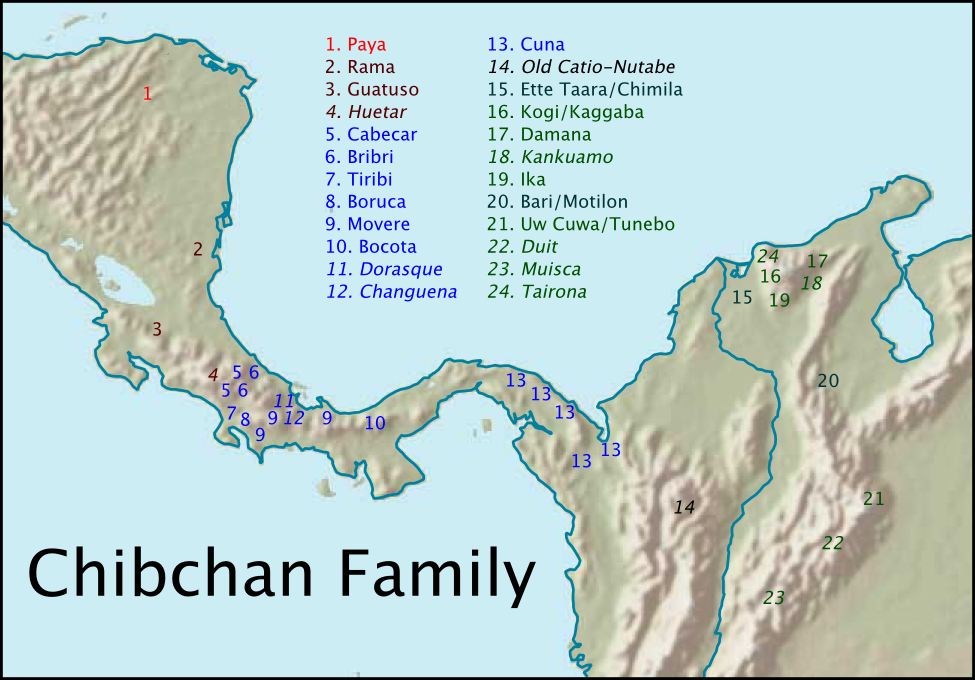
With regard to Chibchan studies, some of my primary interests are the Magdalenic Chibchan languages of northeastern Colombia and the cultures of the people who speak/spoke them.
Different researchers have suggested different periods at which "Magdalenic" Chibchan speakers became established in their historically attested territories: perhaps as early as 400-300 BC, but perhaps not until as late as the 7th-9th centuries AD, and possibly even later. The expansion of Chibcha-speakers south through Colombia may have been checked as they ran into Arawakan-speaking groups expanding northward from Brazil, and Chibcha-speakers in some lowland, coastal territories may have been replaced by Carib-speakers (who began appearing in these regions from perhaps around 1000 AD).
In any event, when the Spanish arrived at the beginning of the 16th century AD there were two main known conglomerations of Magdalenic Chibcha speakers: the Muisca cultural area in the high plateaus of Cundinamarca and Boyacá, and the Tairona cultural area around the Sierra Nevada de Santa Marta, respectively Cundiboyacán and Arhuácan, as shown in this table:
| Magdalenic Chibchan |
| Cundiboyacán | Arhuácan |
| Muisca | Duit | Tunebo (Uw Cuwa) | Kogi | Damana | Ika |
Doubtless, this representation is both overly simplistic and incomplete. In addition to Cundiboyacán and Arhuácan, it is now considered likely that Chilmila (or Ette Taara, presently confined to a few speakers living primarily in Colombia's Department of Magdalena, but originally spoken in a larger region south and west of the Sierra Nevada de Santa Marta that centered on the Ariguaní river valley) and Barí (spoken in the southern part of the Sierra de Perijá, on the Colombian-Venezuelan border) may constitute additional subgroups of Magdalenic Chibchan.
Within Cundiboyacán, the "classical Muisca" recorded for the Sabana de Bogotá by colonial grammarians seems somewhat closer to Duit (from Duitama, 170 km northeast of Bogotá) than it is to Tunebo (called Uw Cuwa by its modern speakers, who live in the Sierra Nevada del Cocuy region about 280 km northeast of Bogotá).
With regard to Arhuácan, Ika and Damana may be more closely related to each other than either is to Kogi, and there is an additional Kankuama (or Atánquez) language, perhaps closely related to Damana, though it's not clear to me whether this language is still living or not (I think there's an effort to preserve -- or revive? -- it in some way, perhaps in a situation analogous to Modern Cornish). Additionally, there seem to be dialectical contrasts within the languages; for example, Reichel-Dolmatoff contrasted the speech of the "northern slopes" Kogi with that of the "western slopes" Kogi. Moreover, though it's not clear just what the how the modern Arhuácan languages relate to, or descend from, the language(s) or dialects spoken in the lowlands of the pre-Conquest Tairona cultural area, priests among the Wiwa (the Damana-speaking tribe) and the Kogi claim knowledge of specialized ritual languages known as, respectively, Terruma shayama and Téižua (sometimes spelled Téijua), and these terms may preserve something of the name recorded by the Spanish colonial chroniclers as "Tairona".
Moreover, there were also other indigenous groups living near or between the Tairona and Muisca cultural areas; these could have spoken languages belonging to known (or additional, unknown) Magdalenic subgroups, or non-Magdalenic Chibchan branches, or other non-Chibchan langauges (if so, most likely Arawakan or Carib). Northern Colombia's extremely difficult, mountainous terrain was probably a factor in encouraging the breakup of Magdalenic Chibchan and could have helped non-Chibchan languages survive as isolates even if they were totally surrounded by Chibchan). Researchers have sometimes tried to assign the languages of various indigenous groups known to have existed in the region to the Chibchan family, but there is simply to little recorded data to do this with any confidence.
|